Best Cut of Beef for Stew Recipe
Ever since humanity first began to upgrade its culinary skills from cremating mammoth steaks over an open fire, slow-cooking has been a vital part of the thrifty cook's repertoire, transforming chewy, hard-working cuts of meat into melting, flavourful tenderness. All you need is some liquid and a little patience. But while other countries celebrate such peasant cuisine, Britain has largely abandoned its own recipes in favour of daubes, bourguignons and osso bucco – a tendency not helped by the word "stew", with its gristly overtones of school dinners and slow-burning resentments. Stewing is an activity for disgraced politicians and lovestruck teenagers, not a precursor to dinner.
Tellingly, Plat du Jour, Jane Grigson's favourite one-pot cookery book, which was first published in 1957, includes recipes for goulash and stroganoff, and an extravagant two for daube, but nothing for anything as boring as a British beef stew. As Darina Allen points out when introducing Ballymaloe's boeuf bourguignon, "in Ireland stew is generally regarded as something you feed the family, not your guests" – an observation which applies equally in the UK. However, I would contend that a good stew made with care doesn't need wine or paprika or soy sauce to make it good enough to serve to the Queen (should she drop round and you're feeling generous).
All beef stew recipes start in much the same way. The meat is briefly browned in fat (dripping, butter, oil, or a mixture, depending on the author) for flavour, along with any other ingredients (carrots and onions form the backbone of most stews, but mushrooms, bacon and other root veg are also common additions), and the whole is then covered with liquid, and left to cook gently until the meat is tender. It can then be thickened with flour, or bulked out with barley or dumplings, or just served as is.
Stew v shin
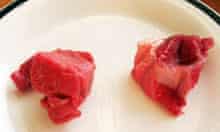
Now I'm no brain surgeon, but when I make beef stew, I usually use stewing steak, a cut which, according to Quality Meat Scotland, generally comes from the top shoulder of the animal. Delia, however, makes a case for using shin – explaining for years she was put off by its "unappealing" appearance, until she realised the connective tissue she found so unattractive would melt during cooking, adding extra flavour and richness to the sauce. "Now," she concludes in her Complete Cookery Course, "for an old-fashioned brown stew, I wouldn't use anything else."
To put her to the test, I make one Delia stew with shin, and one with the generic stewing steak available from the supermarket. The stewing steak is ready at least half an hour earlier, but although it's tender, it lacks the gorgeous silky gelatinous texture of the shin, and the gravy is thinner and less unctuous. Delia, as usual, is right. If you've got the time to cook it, then opt for shin. Make sure you trim it before cooking though, as the silvery sinew on the outside is remarkably resistant stuff.
A question of sauce
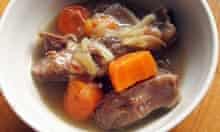
Delia cooks her shin of beef in stock, as do the authors of the Leiths Meat Bible (although they use stewing steak). Jane Grigson, however, has plainer ideas: in English Cookery, she gives a recipe for a shin of beef stew ("I remember asking my mother why she bought shin of beef when other people bought the more expensive – and therefore better, or so I thought – stewing beef," she recalls, in an uncanny echo of Delia's conversion narrative. "She showed me how the rounded nuggets of meat are patterned with a transparent gelatinous membrane which holds them together and add a smooth, jellied texture to the sauce") which was first published in Francatelli's Plain Cookery Book for the Working Classes in 1852.
It's simplicity itself; I cut the beef into pieces "the size of an egg", brown them in dripping, then add a "large handful of flour", carrots and onions, season, cover with water, and "stir the stew on the fire till it boils". At this point it should be removed to the hob (or, if you live in the 21st century, you could just turn the heat down) to simmer gently for about an hour and a half. "You will then be able to enjoy an excellent dinner" concludes Francatelli, formerly chief cook to Queen Victoria, and, according to one website, one of the foremost "culinary celebrities of his time". It's surprisingly decent for something so uncompromisingly plain, but the bland gravy has an undeniable whiff of the workhouse about it.
Taking stock
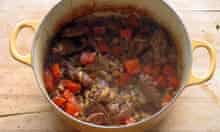
To be fair to her, Grigson does admit in the preface to this recipe that "stock, or better stock and red wine, can be substituted for water". Wine is clearly off-limits to me, but I have a go at the Ballymaloe winter beef stew ("perfect for a shooting lunch"), which uses beef stock in place of Francatelli's water. The gravy is thicker, thanks to the gelatinous stock I use, and the flavour more assertively beefy, but the real breakthrough comes when I open the River Cottage Meat Book, and remember beer.
Hugh Fearnley-Whittingstall's beef in stout recipe is, apparently, "a particularly fine dish to make when you've got some good stewing beef but no stock – the stout makes a good substitute". I quite like the savoury notes the stout brings to the dish, but it's not beefy enough for my tastes, so I take Hugh up on his suggestion that "arguably half stout, half stock would be even better".
It is – rich, meaty, and tangy, these are very British flavours, particularly if you manage to avoid the Irish near-monopoly on stout and ferret out a good one from this country. I discover, after running out of Guinness, that what used to be called milk stout makes a very acceptable substitute; it's sweeter, which makes the gravy more full-bodied, and less bitter.
Thickenings
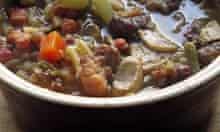
Darina Allen suggests separating the meat and sauce after cooking, and thickening the latter with a roux before serving. It's a nice idea, but fiddly – much easier to add some starch during cooking by flouring the beef before browning it. The Leiths Meat Bible proposes a few handfuls of pearl barley as well, which cooks in the stock along with the beef, but I find it soaks up too much liquid – there's barely any gravy left after a couple of hours on the stove.
Potatoes are a possibility, but we eat so many of the things anyway that I'm inclined to add something a little more traditional instead. I make some suet dumplings according to Jane Grigson's recipe, and drop them into the stew for the last half hour of cooking – and remember why they were one of the best things about school dinners. Is there anything more unashamedly stodgy than a good dumpling?
Flavourings
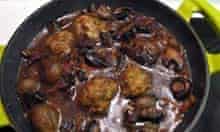
Hugh and Darina both use bacon in their recipes, but I think this is unnecessary – the beef should have enough fat and flavour on its own without any help from other farmyard friends. They're also, like Delia, advocates of mushrooms – ketchup, field and button all go into their stews, but I find fungi a bully. Beef in mushroom gravy is not what I'm after.
However, I do like the idea of adding a bit more veg to the stew to make it a meal in its own right; Darina's celery is a bit mushy, and I find the parsnips in her recipes rather sweet, so I've opted for turnips, on the basis I like them – but any root veg would do. Don't add them at the beginning though, as many recipes do – not all culinary nostalgia deserves encouragement. Stick them in for the last hour, and they should be soft, but not meltingly so. Thyme is one of my favourite herbs to use with beef – that and a bay leaf are about as fancy as I'm prepared to go here.
A word of warning
Lots of stew recipes call for very gentle cooking – but beware, they still need to simmer. As the New York Times food writer, and general food science genius, Harold McGee explains in his book The Curious Cook, "strands of beef collagen don't even begin to unravel until the temperature exceeds 140F (60C), and they don't dissolve into gelatin in any appreciable quantity below 180F (82C)" – so all that those chewy bits will stay just that unless you keep the stew relatively hot.
A hearty stew should be a simple affair – beefy, savoury, and crowned with a ring of fluffy dumplings. No garlic required.
Perfect beef stew
Serves 4 – 6
800g shin of beef
2 tbsp flour, seasoned with salt and pepper
Beef dripping, butter or oil
2 onions, sliced
300ml beef stock
300ml stout
1 bay leaf
3 sprigs of thyme
2 carrots, peeled and cut into chunky slices
2 small turnips, peeled and cut into chunks
For the dumplings:
100g plain flour
1 tsp baking powder
50g suet
Small bunch of chives and parsley, finely chopped
1. Trim the beef of its outer sinew and cut into large chunks. Toss with the seasoned flour to coat. Heat a heavy-bottomed casserole or pan on a medium flame and add a knob of dripping or butter, or a couple of tablespoons of oil. Brown the meat in batches, adding more fat if necessary – be careful not to overcrowd the pan, or it will boil in its own juices – then transfer to a bowl. Scrape the bottom of the pan regularly to prevent any residue from burning.
2. Once all the meat is browned, add some more fat to the pan and cook the onions until soft and slightly browned. Add them to the beef and then pour in a little stock and scrape the bottom of the pan to deglaze it. Add the beef and onions, the rest of the stock and the stout, season, and add the herbs. Bring to the boil, then partially cover, turn down the heat, and simmer gently for two hours.
3. Add the carrots and turnips, and simmer for about another hour, until the meat is tender enough to cut with a spoon. Leave to cool, overnight if possible, and then lift the solidified fat off the top and bring to a simmer.
4. Meanwhile, make the dumplings by sifting the flour into a bowl and adding the rest of the ingredients and just enough cold water to bring it together into a dough. Roll it into 6 dumplings and add these to the stew. Partially cover and simmer for 25 minutes, then check the seasoning of the gravy, and serve with steamed greens.
Is there anything to touch stew and dumplings for sheer nostalgic cockle-warming, and can the British version hold its head high in the face of international competition? If not – seriously, what's better?
hamiltonselinglese.blogspot.com
Source: https://www.theguardian.com/lifeandstyle/wordofmouth/2011/feb/03/how-cook-perfect-beef-stew
0 Response to "Best Cut of Beef for Stew Recipe"
Post a Comment